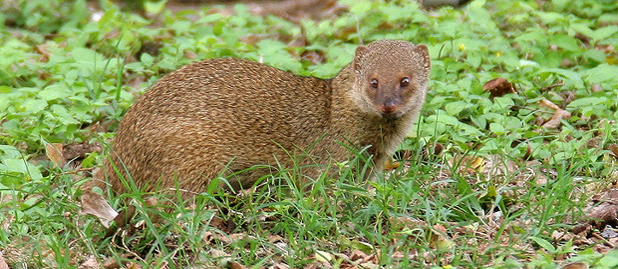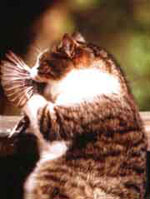|
|
Invasive Species
|

Indian Mongoose by Bill Hubick
|
The Challenge
Between 3,500 - 4,000 species of animals and plants in the U.S. are alien or exotic, i.e., did not evolve here. While many of these species are beneficial to people and provide food for human consumption, pets for companionship, plants for landscaping, erosion control, and other uses, at least 400 species are considered problematic for wildlife or the environment. Some species were deliberately introduced; others came accidentally with shipments of goods from other countries or in ballast waters. Lacking predators from their place of origin or other natural controls on their populations, these species have become invasive and directly threaten the ability of our native plants and animals to survive.
It is estimated that invasive plants in all 50 states occupy more than 100 million acres, and are spreading at the alarming rate of 14 million acres/year, and 4,300 acres/day on public lands alone. This “biological pollution” may cause $130 billion worth of damage/year. Invasive species are considered the #1 threat to the nation’s National Wildlife Refuge (NWR) system– affecting at least 540 NWRs and 3,000 waterfowl areas on 95 million acres in the U.S. & territories managed by the U.S. Fish and Wildlife Service.
World-wide, invasive plants and animals have entirely or partially caused the majority of all bird extinctions since 1800. More than one third of the birds on American Bird Conservancy’s “Watchlist” are threatened by invasive species. Monocultures formed by exotic plants are particularly unfit for bird habitat. Birds require habitat containing a variety of plant species, variation in horizontal canopy cover, and complexity in vertical structure. In contrast, invasive exotic infestations are comprised of one species, mostly uniform in height and structure, and form a canopy coverage that is too dense.
ABC Conservation Framework
Invasive species can represent a mortality threat to a wode spectrum of birds, can decimate bird habitats, and threaten the rarest birds with extinction. This phenomenon therefore falls under all three aspects of ABC's conservation framework: Safeguarding the Rarest, Conserving Habitats, and Eliminating Threats. |
 |
 |
 |
Safeguarding the Rarest |
Conserving Habitats |
Eliminating Threats |
|
Primary Birds Impacted
All bird species are affected by introduced species to one degree or another, but some are particularly threatened. These include island endemics, such as those on Hawaii and Guam, that are predated by introduced mammals or reptiles, or whose habitat is dramatically altered by the grazing of introduced ungulates. Introduced mammals can also spread introduced diseases such as malaria. Invasive plants such as cheat grass are also a threat to birds such as sage-grouse in sensitive mainland habitats.
Solutions
Eradicating rats, cats, and other predators, as well as destructive ungulates from islands that are home to endemic species or concentrations of breeding birds is essential. Domestic cats kill hundreds of millions of birds throughout the United States. All owned cats should be kept indoors and people prevented from maintaining feral cat colonies. Strategic eradication of invasive plants, such as Verbesina on Midway, should be undertaken to aid specific bird populations.
ABC Results
 |
.ABC has created the Cats Indoors Campaign as a means of alerting the public to the dangers outdoor cats pose to birds, other wildlife, and human health, and provides comprehensive information for people wishing to keep their cats indoors or begin a local campaign. Read more here |
 |
ABC has begun a major initiative in Hawaii, working to protect native species such as the Palila and I'iwi from invasive predators, ungulates, plants, and disease. Read more here. |
 |
ABC has supported introduction of the Refuge Ecology Protection Assistance and Immediate Response Act, which aims to provide grants to detect invasive species and mitigate their impacts on National Wildlife Refuges. |
What Next?
| |
Learn More About Invasive Species |
 |
|
|
|
Take Action
- Always keep your cat indoors
- Support local cat leash laws and laws to ban Trap Neuter Release of cats at colonies
- Call your Representative with your support for the Refuge Ecology Protection Assistance and Immediate Response Act (REPAIR)
- Never release unwanted pets into the wild. Take them to a shelter.
|
| |
|
| |
|
| |
|
| |
|
| |
|
| |
|
|
|
|
|